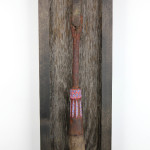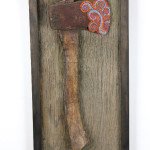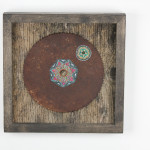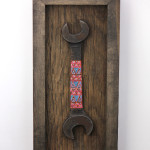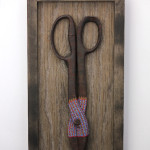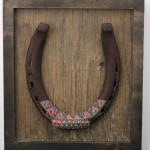Artist Statement
“I am a Fairbanks artist who has had solo exhibits at the Alaska House since 2008. I began noticing how people interacted with the patterns I was creating and how they wanted to touch the beaded patterns on the clayboard surfaces. Shortly afterwards, I began experimenting with painting on small stones collected from Alaska’s Interior. For the 2010 Alaska House exhibit, Living Narratives, I framed my painted stones in wooden boxes, exploring how the wood grain of oak, the organic shape and line of the stones, and the hand-painted patterns interacted and harmonized with each other. For the 2012 Alaska House exhibit, ALCHEMY, an eclectic collection of found objects—antlers, railroad spikes, glass floats, rusty oil cans and a spoon, bottles and screws—became the canvasses for my geometric, beadwork patterns. These pieces represented a new direction for my art.
“Today, my husband, Matt and I share a passion for collecting castaway vintage items and forgotten rust pieces: “Made in USA” tools, skeleton keys, kitchen ware, small antique curiosities like oil cans, cow bells, railroad spikes, and pastry cutters. Together, we re-image these bits of history into art. Through the color patterns and beaded geometric designs, I endeavor to create a visual harmony between the finished artwork and the found object—a harmony further enhanced by Matt’s framing with local birch and scavenged, reclaimed weathered plywood.
“However, the process for creating my artwork has changed over the past two years. In October of 2013, my husband Matt and I welcomed daughter Lola into the world. In preparing for future exhibitions, I had to suspend my belief that I needed the painting marathon of my pre-Lola days to produce a finished collection of art. I had to trust that my stolen hours and piecemeal workdays—and my often sleep-deprived state—would be enough. Alaska is a body of work born from these stolen hours. In trusting my process—connecting one dot, then another, one hour, then another—colorful geometries emerged and finished pieces were created.”

